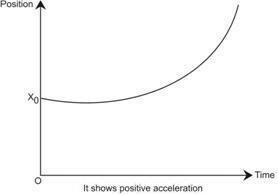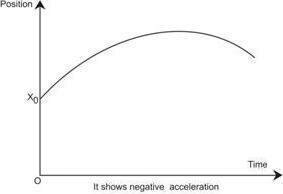Definition
Acceleration of an object is defined as the time rate of change of velocity of an object.
Introduction
We often see that the velocity of a vehicle moving on road is never uniform. Its a velocity that changes randomly. Such a motion is called an accelerated motion.
Thus, acceleration is the change in velocity in each unit of time. If the change in velocity in each unit of time is constant, the object is said to be moving with constant acceleration. Such a motion is known as uniformly accelerated motion. If the change in velocity in unit time is not constant then the motion is said to be non-uniformly accelerated motion.
Acceleration is a vector quantity. It is positive if there is an increase in velocity otherwise it will be negative. The negative value of acceleration is called ‘Retardation’.Mathematically,
![]()
The unit of acceleration in S.I. system of unit is m/s². In C.G.S. system of units, it is expressed as cm/s². The dimensional formula of acceleration is [ML°T²].
Types of Acceleration
- Uniform Acceleration : An object is said to be uniformly accelerated if its velocity changes by equal amounts in equal interval of time.
- Variable Acceleration : An object is said to be moving with variable acceleration if velocity changes by unequal moments in equal interval of time.
- Average Acceleration : When an object is not moving with uniform acceleration, that is, it is moving with variable acceleration, then the Average Acceleration of it is given as the ratio of the total change in velocity of the object during motion to the total time taken that is
![]()
- Instantaneous Acceleration : When object is moving in such a way that it has different acceleration at different instants, then the acceleration of the object at any given instant of time is called its Instantaneous acceleration.
Let an object is moving with non-uniform acceleration. It means it possesses different velocities at different time instants. Suppose ‘v’ and ‘v+Δv’ are the velocities of this object at instant of time ‘t’ and ‘t+Δt’,where ‘Δt’ is very small interval of time.
Then instantaneous acceleration of an object is defined as the limiting value of the average acceleration of the object in a small time interval around that instant, when the time interval approaches zero.That is,

Since

We may write

Thus, according to equation (1), instantaneous acceleration of an object is equal to time derivative of the instantaneous velocity and from equation (2), it is equal to the second time derivative of the instantaneous position of the object at that given instant.
Important graphs for Acceleration
Velocity-time graph can easily depict acceleration of the body. It gives an idea about positive, negative, zero, increasing or decreasing acceleration.
Case (i) : When body moves with constant velocity
It means its acceleration is zero as there is no change in the velocity.

________________________________________________________
Case (ii) : When a body has constant positive acceleration with zero initial velocity.
The velocity-time graph will be a straight line inclined to time axis.

OA shows constant positive acceleration, slope of graph is less than 900.
________________________________________________________
Case (iii) : When body has constant positive acceleration with initial velocity (say ‘u’).

O1A shows positive acceleration with initial velocity u.
________________________________________________________
Case (iv) : When body is moving with decreasing acceleration that is,it has negative acceleration.
The body in such a case will undergo Constant Retardation.

AB indicates velocity decreases, Slope is negative and greater than 900.
________________________________________________________
Case (v) : When body possesses decreasing or increasing acceleration but decrease and increase is not constant then V-T graph is as follows :

Dotted curve OA shows decreasing acceleration where slope decreases with time. Dotted curve OB shows increasing acceleration where slope increases with time.
Position-time graph can also depict acceleration of the body. As we know that second derivative of position gives acceleration
That is,
![]()
Therefore, graph plotted on Position and time axis will be a Parabola.


Key points :
- If the body is moving with a constant acceleration then for calculating various parameters,three equations of motion are used that is,
V = u + at
S = ut + ½at²
V² = u² + 2as
- When acceleration of a body is not constant, integration of acceleration will give ‘velocity’ and integration of velocity will give ‘displacement’.
- The equations of motion cannot be applied to Circular Motion or Simple Harmonic Motion.
References :-
- Pradeep’s Fundamental Physics (XI)
- Modern’s abc of physics (vol.1)
- Mootan Physics by kumar – Miltal
